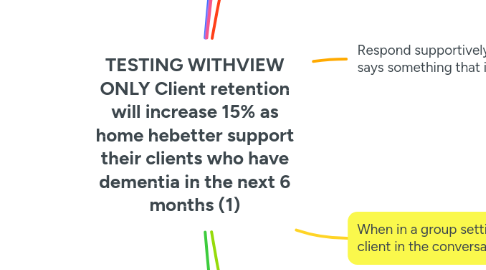TESTING WITHVIEW ONLY Client retention will increase 15% as home hebetter support their clients who have dementia in the next 6 months (1)
von Amy Pluto


1. Created using Cathy Moore’s action mapping model. Instructional design by Amy Pluto.
2. Use an adult voice
3. Acknowledge client's achievements
4. Maintain eye contact
5. Speak to client in a respectful, non-patronizing way
5.1. Use a calm tone
5.2. Use a friendly tone
5.3. Use client's name
5.4. Don't use complex language
5.5. Gently remind client of the topic of the conversation if necessary
5.6. Validate client's feelings
5.7. Give client time to respond
6. Respond supportively when client says something that is not accurate
6.1. Validate client's emotions
6.1.1. For example, if client expresses sadness about something that didn't happen, say,"I understand that you're feeling sad."
6.2. Go along with the story
6.2.1. For example, if client says they visited a place that they didn't, say, "That sounds like it was a wonderful trip."
6.3. If client is fixated on a particular topic, redirect client's attention
6.3.1. Gently introduce a different topic
6.3.2. Gently introduce a different activity
7. When in a group setting, involve client in the conversation
8. Offer client choices
8.1. Offer two choices
8.2. Offer simple choices
8.3. Offer appropriate choices
8.3.1. Align choices to client's needs
8.3.2. Align choices to client's capabilities
8.3.3. Align choices to client's preferences
8.3.3.1. Use visual cues
8.3.3.1.1. For example, holding up the choices so client can visualize the choice
8.3.4. Ask open-ended questions
